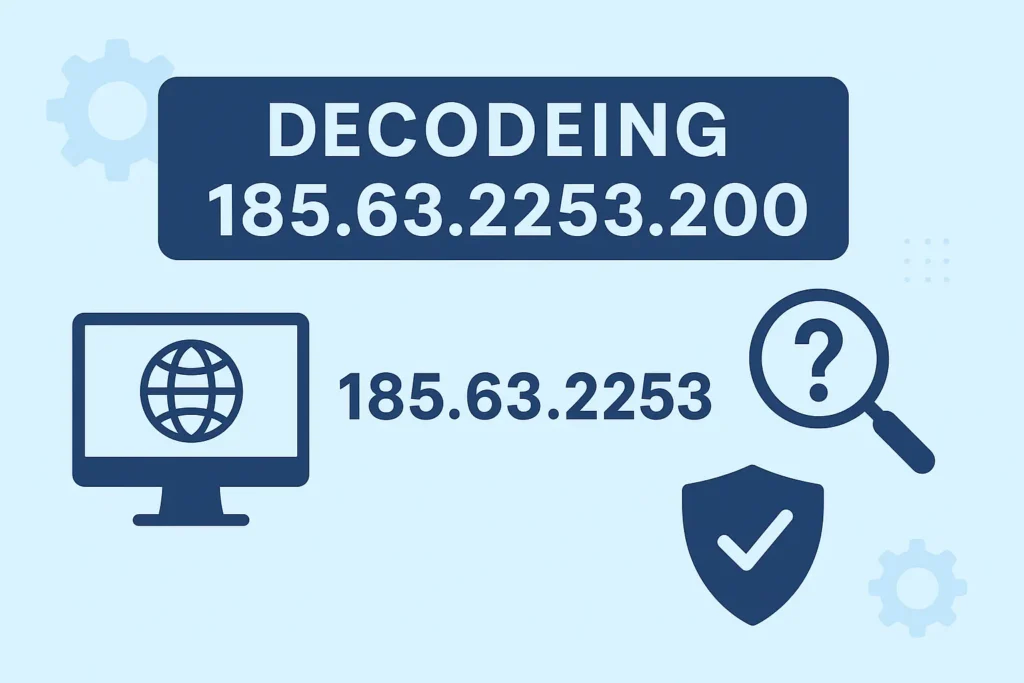Every now and then, a string of numbers in a log file or server report can stop an administrator in their tracks. One such sequence is 185.63.2253.200. At first glance, it resembles an IP address. On closer inspection, it becomes clear that something is off. Is it a harmless error, a formatting mishap, or an indication of something more serious happening on the network? This article provides a deep dive into the meaning, possible origins, investigation techniques, and preventive strategies for dealing with 185.63.2253.200.
By the end of this guide, you will know why it appears, how to check related valid addresses, and how to ensure your systems are protected from anomalies that could disrupt your data integrity and security.
Understanding the Structure of an IP Address
To understand why 185.63.2253.200 is unusual, we need to revisit the fundamentals of IPv4 addressing. IPv4 addresses consist of four numerical blocks (called octets) separated by periods. Each octet must be a number between 0 and 255. For example, 192.168.0.1 is a valid IPv4 address.
In 185.63.2253.200, the third octet reads “2253.” This exceeds the allowable range and instantly makes the address invalid. Such a number sequence would never be assigned to a device, server, or service on the internet. Knowing this rule helps you quickly classify 185.63.2253.200 as a malformed or incorrect entry.
Why 185.63.2253.200 Might Appear in Data or Logs
It’s natural to assume a malformed address is just a random mistake, but there are several reasons why 185.63.2253.200 might show up:
- Human Error
A typist entering data into a system could accidentally hit extra digits. In high-volume logging or manual network configuration, even one slip can create an entry like 185.63.2253.200. - Software or Script Formatting Issues
Sometimes log-generating tools concatenate numbers incorrectly due to bugs, missing separators, or faulty data parsing, creating invalid outputs. - Test or Placeholder Data
Developers and QA testers may insert fake addresses to simulate traffic. If these test entries are not cleaned up, they might be mistaken for real data later. - Malicious Noise
Attackers can deliberately generate invalid data to clutter logs, making it harder for analysts to detect genuine threats. This is sometimes called log pollution or data obfuscation. - Data Corruption
Network or file corruption during transfer could alter valid addresses into malformed ones.
Common Valid Addresses Near 185.63.2253.200
If we remove the error in the third octet, there are a couple of plausible intended addresses:
- 185.63.225.200 – This belongs to the 185.63.225.0/24 block, typically assigned to a specific hosting provider or regional network.
- 185.63.253.200 – Another nearby valid address in the 185.63.253.x range, sometimes seen in data center allocations.
Both of these valid IPs could replace the malformed entry in a corrected dataset. Checking them through WHOIS lookups or IP reputation tools can reveal ownership, geolocation, and whether they’ve been reported for abuse.
Security Risks Associated With 185.63.2253.200
While it’s invalid as an actual IP, the repeated appearance of 185.63.2253.200 could still indicate risky patterns. Potential security implications include:
- Masking Attacks – Malformed entries might hide malicious source addresses.
- Evasion of Detection – Security tools expecting valid IPv4 patterns may skip analysis, letting an attacker operate unnoticed.
- Noise Flooding – Logs filled with useless entries like 185.63.2253.200 make it harder for analysts to find real threats.
- Script Testing by Attackers – Malformed inputs are sometimes used to test system validation and error handling.
Step-by-Step Process for Investigating 185.63.2253.200
Step 1: Preserve Original Data
Never overwrite or delete the raw log entry. Store it in a secure archive so you can reference it later if needed for incident reports.
Step 2: Check Frequency and Timing
Is this a one-time occurrence or does it happen repeatedly? Recurring entries suggest automation.
Step 3: Correlate With Other Events
Look for login failures, admin page requests, or API calls in the same timeframe.
Step 4: Normalize to Likely Valid IPs
Try correcting the malformed octet and searching for activity from valid candidates like 185.63.225.200 or 185.63.253.200.
Step 5: Conduct WHOIS and Reputation Checks
Determine if the corrected IPs are linked to hosting providers, known botnets, or blacklisted addresses.
Step 6: Investigate Related Domains
If the IPs are tied to specific domains, scan those for signs of phishing, malware hosting, or suspicious activity.
Best Practices to Prevent Malformed Entries Like 185.63.2253.200
1. Input Validation
Use strict regex patterns to ensure any IP address captured in logs matches the dotted-quad IPv4 format and each segment is within the 0–255 range.
2. Store Both Raw and Cleaned Data
Having a normalized log helps with automated analysis, while raw logs maintain original evidence for manual review.
3. Enable Automated Alerts
Set up alerts when invalid IP patterns appear, so they can be investigated in real-time.
4. Conduct Routine Log Audits
Regular manual checks help you spot patterns that automated systems might miss.
5. Educate Teams on Data Hygiene
Training administrators and developers on the importance of proper data entry and validation helps avoid accidental errors.
Why This Information Matters for SEO and User Value
Articles like this, explaining a specific and unusual topic such as 185.63.2253.200, provide real value to readers searching for clarity. Search engines reward pages that:
- Directly answer a user’s question.
- Offer actionable steps, not just definitions.
- Use relevant keywords naturally (not stuffed unnaturally).
- Include structured, scannable sections with headings and FAQs.
By making this guide comprehensive and easy to read, it stands a stronger chance of ranking for searches about 185.63.2253.200 and related terms.
FAQs
Q1: Is 185.63.2253.200 a valid IP address?
No. The third octet exceeds the maximum allowed number for IPv4, making it invalid.
Q2: Why would I see 185.63.2253.200 in my logs?
It could be due to typos, data formatting errors, placeholder test data, or malicious noise.
Q3: What’s the best way to investigate it?
Keep the original record, normalize it to likely valid IPs, run WHOIS lookups, and check for related suspicious activity.
Q4: Can 185.63.2253.200 be linked to cyberattacks?
Yes, repeated malformed entries can be part of evasion tactics or log pollution by attackers.
Q5: How can I stop such entries in the future?
Use strict input validation, maintain separate raw and cleaned logs, and set alerts for malformed patterns.
Conclusion
The string 185.63.2253.200 might look like a technical detail too small to matter, but in the world of security and data management, small anomalies can be the early warning signs of larger issues. Whether it’s a harmless typo or part of a sophisticated attempt to confuse log analysis, the key is to investigate systematically.
By understanding why 185.63.2253.200 is invalid, knowing which valid addresses might have been intended, and applying best practices for log hygiene, you can maintain accurate records, respond quickly to threats, and keep your systems running smoothly. In cybersecurity, awareness is your first defense, and even a single malformed address can tell a bigger story when you know how to read it.

